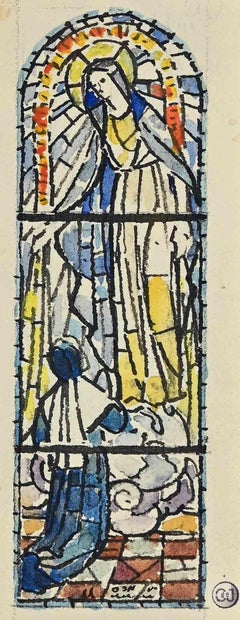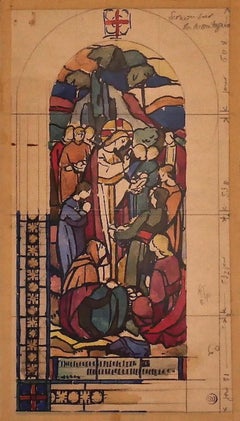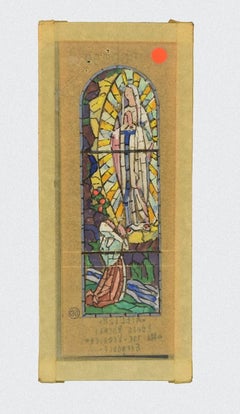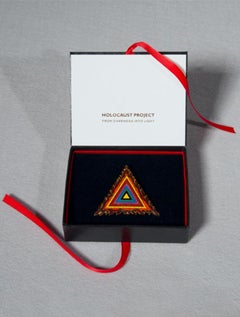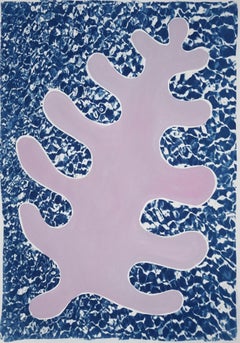Louis Balmet Art
1876-1957
Louis Balmet was a glass master, who worked until 1936. He was a member of the French committee of expositions. Balmet attended the Universal Exposition of 1906 and the International Exposition of 1908.
to
1
3
3
3
Overall Height
to
Overall Width
to
2
3
1
1
3
6,935
3,285
2,514
1,213
3
2
2
2
Artist: Louis Balmet
Sketch for a Glass-window - Ink and Watercolor by Louis Balmet - 1950s
By Louis Balmet
Located in Roma, IT
Sketch for a Glasswindow is an original modern artwork realized in the 1950s by the French artist and glassmaster Louis Balmet.
Original artwork realized in China Ink ans watercolo...
Category
1950s Modern Louis Balmet Art
Materials
Ink, Mixed Media, Watercolor
Madonna - Original Mixed Media by Louis Balmet - First Half 20th Century
By Louis Balmet
Located in Roma, IT
Madonna is an original artwork realized by Louis Balmet in the first half of the XX century. Mixed media (ink and watercolor) on paper.
The artwork is a study for a glass-window.
W...
Category
Early 20th Century Louis Balmet Art
Materials
Mixed Media
Sketch for a Glass-window - Ink and Watercolor by Louis Balmet - 1920s
By Louis Balmet
Located in Roma, IT
Original Sketch for a Glass-window is a modern artwork realized in the 1920s by the French artist and glassmaster Louis Balmet (1876 - 1957).
Original artwork realized in China Ink ...
Category
1920s Modern Louis Balmet Art
Materials
Mixed Media, Ink, Watercolor
Related Items
Holocaust Remembrance Logo Pin and Pendant
By Judy Chicago
Located in New York, NY
Judy Chicago
Logo Pin and Pendant, 1993
Enameled pin with pendant loop in original presentation box
2 1/2 × 2 1/2 × 1/5 inches
Judy Chicago's incised name and date on the verso
Comes in original presentation gift box
Poignant enameled Holocaust Project Logo pin & pendant based on the logo designed by Judy Chicago for the Holocaust Project: From Darkness into Light
More about pioneering artist Judy Chicago
Judy Chicago (born Judith Sylvia Cohen; July 20, 1939) is an American feminist artist, art educator, and writer known for her large collaborative art installation pieces about birth and creation images, which examine the role of women in history and culture. During the 1970s, Chicago founded the first feminist art program in the United States at California State University, Fresno (formerly Fresno State College) which acted as a catalyst for feminist art and art education during the 1970s. Her inclusion in hundreds of publications in various areas of the world showcases her influence in the worldwide art community. Additionally, many of her books have been published in other countries, making her work more accessible to international readers. Chicago's work incorporates a variety of artistic skills, such as needlework, counterbalanced with skills such as welding and pyrotechnics. Chicago's most well known work is The Dinner Party, which is permanently installed in the Elizabeth A. Sackler Center for Feminist Art at the Brooklyn Museum. The Dinner Party celebrates the accomplishments of women throughout history and is widely regarded as the first epic feminist artwork. Other notable art projects by Chicago include International Honor Quilt, Birth Project, Powerplay, and The Holocaust Project. She is represented by Jessica Silverman...
Category
1990s Abstract Geometric Louis Balmet Art
Materials
Metal, Enamel
Organic Lilac Flower, Organic Painting Style, Pastel Purple, Abstract Background
Located in Barcelona, ES
This is an exclusive handmade mixed media cyanotype with hand-painted acrylic paint in pastel tones.
Details:
Title: Lilac Leaf on Water
Medium: Mixed Media on Watercolor Paper
Size: 100x70 cm
Year: 2020
*Frame is for illustrative purposes only, artwork is shipped carefully rolled in a tube.
WHAT IS A CYANOTYPE?
The cyanotype (a.k.a. sun-print) process is one of the oldest in the history of photography, dating back to the 1840's.
Cyanotypes were then made famous by Anna Atkins...
Category
2010s Abstract Louis Balmet Art
Materials
Archival Ink, Mixed Media, Oil, Acrylic, Watercolor, Archival Paper
Refreshing Gelato Grid, Vivid Tones Modern Painting, Diptych, Cabin Beach, 2021
Located in Barcelona, ES
"Refreshing Gelato Grid" is an abstract painting by Spanish artist Natalia Roman. It is a beautiful series of rhythmic brushstrokes combined with subtle tones and unique shapes that is both classy and fresh. The use of vivid colors on a white background reminds the beautiful vintage beach cabins...
Category
2010s Expressionist Louis Balmet Art
Materials
Archival Ink, Mixed Media, Oil, Acrylic, Watercolor, Archival Paper
Acrylic Painting of Pastel Dreamy Drips, Mixed Media Subtle Rainbow, Cyanotype
Located in Barcelona, ES
This is an exclusive handmade mixed media cyanotype with hand-painted acrylic paint in pastel tones.
Details:
Title: Pastel Dreamy Drips
Medium: Mixed Media on Watercolor Paper
Siz...
Category
2010s Modern Louis Balmet Art
Materials
Archival Ink, Mixed Media, Oil, Acrylic, Watercolor, Archival Paper
1950s Abstract Composition in Brown, Orange and Blue with Black Parallel Lines
By Herbert Bayer
Located in Denver, CO
Watercolor and ink on paper of an abstract composition of brown, orange and blue shapes between black parallel lines throughout the the piece by Herbert Bayer (1900-1985). Presented in a custom black frame with all archival materials. Framed dimensions measure 17 ⅞ x 22 ⅝ x 1 inches. Image size is 10 ¼ x 15 ½ inches.
Painting is clean and in very good condition - please contact us for a detailed condition report.
Expedited and international shipping is available - please contact us for a quote.
About the Artist:
Herbert Bayer enjoyed a versatile sixty-year career spanning Europe and America that included abstract and surrealist painting, sculpture, environmental art, industrial design, architecture, murals, graphic design, lithography, photography and tapestry. He was one of the few “total artists” of the twentieth century, producing works that “expressed the needs of an industrial age as well as mirroring the advanced tendencies of the avant-garde.”
One of four children of a tax revenue officer growing up in a village in the Austrian Salzkammergut Lake region, Bayer developed a love of nature and a life-long attachment to the mountains. A devotee of the Vienna Secession and the Vienna Workshops (Wiener Werkstätte) whose style influenced Bauhaus craftsmen in the 1920s, his dream of studying at the Academy of Art in Vienna was dashed at age seventeen by his father’s premature death.
In 1919 Bayer began an apprenticeship with architect and designer, Georg Schmidthamer, where he produced his first typographic works. Later that same year he moved to Darmstadt, Germany, to work at the Mathildenhöhe Artists’ Colony with architect Emanuel Josef Margold of the Viennese School. As his working apprentice, Bayer first learned about the design of packages – something entirely new at the time – as well as the design of interiors and graphics of a decorative expressionist style, all of which later figured in his professional career.
While at Darmstadt, he came across Wassily Kandinsky’s book, Concerning the Spiritual in Art, and learned of the new art school, the Weimar Bauhaus, in which he enrolled in 1921. He initially attended Johannes Itten’s preliminary course, followed by Wassily Kandinsky’s workshop on mural painting. Bayer later recalled, “The early years at the Bauhaus in Weimar became the formative experience of my subsequent work.” Following graduation in 1925, he was appointed head of the newly-created workshop for print and advertising at the Dessau Bauhaus that also produced the school’s own print works. During this time he designed the “Universal” typeface emphasizing legibility by removing the ornaments from letterforms (serifs).
Three years later he left the Bauhaus to focus more on his own artwork, moving to Berlin where he worked as a graphic designer in advertising and as an artistic director of the Dorland Studio advertising agency. (Forty years later he designed a vast traveling exhibition, catalog and poster -- 50 Jahre Bauhaus -- shown in Germany, South America, Japan, Canada and the United States.) In pre-World War II Berlin he also pursued the design of exhibitions, painting, photography and photomontage, and was art director of Vogue magazine in Paris. On account of his previous association with the Bauhaus, the German Nazis removed his paintings from German museums and included him among the artists in a large exhibition entitled Degenerate Art (Entartete Kunst) that toured German and Austrian museums in 1937.
His inclusion in that exhibition and the worsening political conditions in Nazi Germany prompted him to travel to New York that year with Marcel Breuer, meeting with former Bauhaus colleagues, Walter Gropius and László Moholy-Nagy to explore the possibilities of employment after immigration to the United States. In 1938 Bayer permanently relocated to the United States, settling in New York where he had a long and distinguished career in practically every aspect of the graphic arts, working for drug companies, magazines, department stores, and industrial corporations. In 1938 he arranged the exhibition, “Bauhaus 1919-1928” at the Museum of Modern Art, followed later by “Road to Victory” (1942, directed by Edward Steichen), “Airways to Peace” (1943) and “Art in Progress” (1944).
Bayer’s designs for “Modern Art in Advertising” (1945), an exhibition of the Container Corporation of America (CAA) at the Art Institute of Chicago, earned him the support and friendship of Walter Paepcke, the corporation’s president and chairman of the board. Paepcke, whose embrace of modern currents and design changed the look of American advertising and industry, hired him to move to Aspen, Colorado, in 1946 as a design consultant transforming the moribund mountain town into a ski resort and a cultural center. Over the next twenty-eight years he became an influential catalyst in the community as a painter, graphic designer, architect and landscape designer, also serving as a design consultant for the Aspen Cultural Center.
In the summer of 1949 Bayer promoted through poster design and other design work Paepcke’s Goethe Bicentennial Convocation attended by 2,000 visitors to Aspen and highlighted by the participation of Albert Schweitzer, Arthur Rubenstein, Jose Ortega y Gasset and Thornton Wilder. The celebration, held in a tent designed by Finnish architect Eero Saarinen, led to the establishment that same year of the world-famous Aspen Music Festival and School regarded as one of the top classical music venues in the United States, and the Aspen Institute for Humanistic Studies in (now the Aspen Institute), promoting in Paepcke’s words “the cross fertilization of men’s minds.”
In 1946 Bayer completed his first architecture design project in Aspen, the Sundeck Ski Restaurant, at an elevation of 11,300 feet on Ajax Mountain. Three years later he built his first studio on Red Mountain, followed by a home which he sold in 1953 to Robert O. Anderson, founder of the Atlantic Richfield Company who became very active in the Aspen Institute. Bayer later designed Anderson’s terrace home in Aspen (1962) and a private chapel for the Anderson family in Valley Hondo, New Mexico (1963).
Transplanting German Bauhaus design to the Colorado Rockies, Bayer created along with associate architect, Fredric Benedict, a series of buildings for the modern Aspen Institute complex: Koch Seminar Building (1952), Aspen Meadows guest chalets and Center Building (both 1954), Health Center and Aspen Meadows Restaurant (Copper Kettle, both 1955). For the grounds of the Aspen Institute in 1955 Bayer executed the Marble Garden and conceived the Grass Mound, the first recorded “earthwork” environment In 1973-74 he completed Anderson Park for the Institute, a continuation of his fascination with environmental earth art.
In 1961 he designed the Walter Paepcke Auditorium and Memorial Building, completing three years later his most ambitious and original design project – the Musical Festival Tent for the Music Associates of Aspen. (In 2000 the tent was replaced with a design by Harry Teague.) One of Bayer’s ambitious plans from the 1950s, unrealized due to Paepcke’s death in 1960, was an architectural village on the outskirts of the Aspen Institute, featuring seventeen of the world’s most notable architects – Walter Gropius, Marcel Breuer, I.M. Pei, Minoru Yamasaki, Edward Durrell Stone and Phillip Johnson – who accepted his offer to design and build houses.
Concurrent with Bayer’s design and consultant work while based in Aspen for almost thirty years, he continued painting, printmaking, and mural work. Shortly after relocating to Colorado, he further developed his “Mountains and Convolutions” series begun in Vermont in 1944, exploring nature’s fury and repose. Seeing mountains as “simplified forms reduced to sculptural surface in motion,” he executed in 1948 a series of seven two-color lithographs (edition of 90) for the Colorado Springs Fine Arts Center. Colorado’s multi-planal typography similarly inspired Verdure, a large mural commissioned by Walter Gropius for the Harkness Commons Building at Harvard University (1950), and a large exterior sgraffito mural for the Koch Seminar Building at the Aspen Institute (1953).
Having exhausted by that time the subject matter of “Mountains and Convulsions,” Bayer returned to geometric abstractions which he pursued over the next three decades. In 1954 he started the “Linear Structure” series containing a richly-colored balance format with bands of sticks of continuously modulated colors. That same year he did a small group of paintings, “Forces of Time,” expressionist abstractions exploring the temporal dimension of nature’s seasonal molting. He also debuted a “Moon and Structure” series in which constructed, architectural form served as the underpinning for the elaboration of color variations and transformations.
Geometric abstraction likewise appeared his free-standing metal sculpture, Kaleidoscreen (1957), a large experimental project for ALCOA (Aluminum Corporation of America) installed as an outdoor space divider on the Aspen Meadows in the Aspen Institute complex. Composed of seven prefabricated, multi-colored and textured panels, they could be turned ninety degrees to intersect and form a continuous plane in which the panels recomposed like pieces of a jigsaw puzzle. He similarly used prefabricated elements for Articulated Wall, a very tall free-standing sculpture commissioned for the Olympic Games in Mexico...
Category
1950s Abstract Geometric Louis Balmet Art
Materials
Paper, Ink, Mixed Media, Watercolor
H 17.75 in W 22.5 in D 1 in
James Bonstow, Approaching River Dart IV, Original Landscape Art
Located in Deddington, GB
Approaching River Dart IV by James Bonstow [2021]
Original
Watercolour And Ink
Image size: H:29 cm x W:35 cm
Complete Size of Unframed Work: H:29 cm x W:35 cm x D:0.1cm
Sold Unframed...
Category
21st Century and Contemporary Contemporary Louis Balmet Art
Materials
Paper, Ink, Mixed Media, Watercolor
H 11.42 in W 13.78 in
Medieval French Charter House Library - Miniature Room by Kupjack Studios
By Henry "Hank" Kupjack
Located in Chicago, IL
Kupjack Miniatures
Medieval French Charter-House Library, Normandy France, circa 1425, 2012
mixed media
16.50h x 27.75w x 15d in
41.91h x 70.48w x 38.10d cm
KJK002
Eugene Kupjack and his sons Hank and Jay created museum quality miniature rooms...
Category
21st Century and Contemporary Medieval Louis Balmet Art
Materials
Mixed Media
H 16.5 in W 27.75 in D 15 in
"Up North Series: Birch Bark Otter Lake, " Mixed Media signed by David Barnett
By David Barnett
Located in Milwaukee, WI
"Up North Series: Birch Bark Otter Lake" is an original mixed media painting by David Barnett. The artist scanned a piece of birch bark and then painted over the image with ink and w...
Category
Early 2000s Impressionist Louis Balmet Art
Materials
Ink, Mixed Media, Watercolor, Pencil
Loose Strokes on Sky Blue, Abstract Gestures Patterns, Acrylic Painting on Paper
Located in Barcelona, ES
"Loose Strokes on Sky Blue" is an abstract painting by Spanish artist Natalia Roman. It is a beautiful series of rhythmic brushstrokes combined with subtle tones and unique shapes th...
Category
2010s Abstract Louis Balmet Art
Materials
Archival Ink, Mixed Media, Oil, Acrylic, Watercolor, Archival Paper
'Paternoster', bed sheet, mixed media, wool, canvas, abstract, contemporary, art
By Meike Legler
Located in Los Angeles, US
'Paternoster,' 2023
Buried bed sheet and wool over stretched canvas
50 cm x 40 cm
19.6 x. 15.7 inches
Meike Legler’s works are a bold post-feminist reframing of sewn objects, recont...
Category
21st Century and Contemporary Contemporary Louis Balmet Art
Materials
Wool, Canvas, Mixed Media
'Hereditary Flaws', Mixed fabrics, vintage linen, abstract, contemporary, art
By Meike Legler
Located in Los Angeles, US
'Hereditary Flaws,' 2020
Mixed fabrics over stretched vintage linen
36 x 48 inches
Meike Legler’s works are a bold post-feminist reframing of sewn objects, recontextualized far beyo...
Category
21st Century and Contemporary Contemporary Louis Balmet Art
Materials
Fabric, Textile, Linen, Mixed Media
Train Tracks
By Bob Dylan
Located in London, GB
Bob DYLAN (1941-)
Train Tracks
mixed media
76 x 61 cm
Signed
Dylan's iconic Train Tracks image has resonated with fans and collectors since the initial s...
Category
21st Century and Contemporary Contemporary Louis Balmet Art
Materials
Mixed Media
Louis Balmet art for sale on 1stDibs.
Find a wide variety of authentic Louis Balmet art available for sale on 1stDibs. You can also browse by medium to find art by Louis Balmet in mixed media, ink, paint and more. Much of the original work by this artist or collective was created during the 20th century and is mostly associated with the modern style. Not every interior allows for large Louis Balmet art, so small editions measuring 2 inches across are available. Customers who are interested in this artist might also find the work of José Luis Rey Vila, Rene Couturier, and Suzan Etkin. Louis Balmet art prices can differ depending upon medium, time period and other attributes. On 1stDibs, the price for these items starts at $251 and tops out at $494, while the average work can sell for $434.
